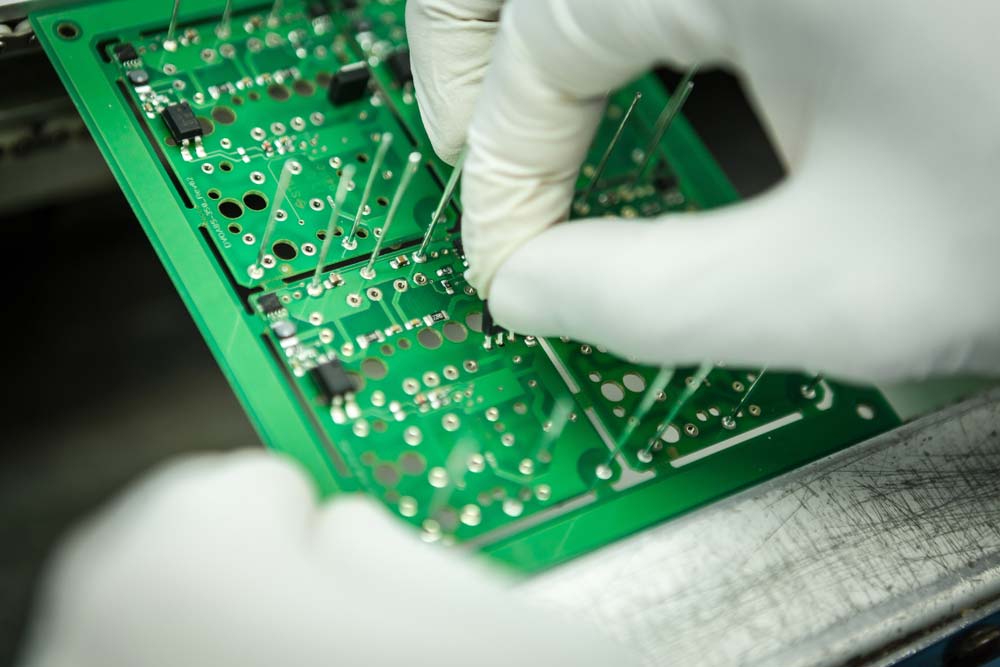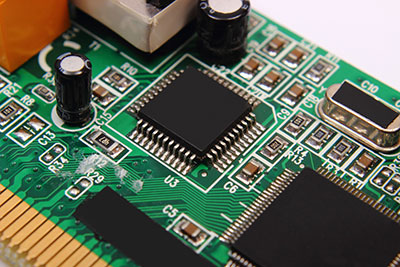Printed circuit boards come in various colors, suitable for the intended application. For example, a purple or red board can provide testing and leakage reduction capabilities.
It makes them unique compared to conventional boards, which consist of a green solder mask.
However, anyone considering a purple PCB will need to pay the manufacturer a bit more, even if it looks like an attractive option.
After reading this article, you will gain a general understanding of the purple circuit board. So let’s take a look!
Contents
- What is a Purple PCB?
- Why Choose a Purple Circuit Board?
- Best PCB Material for Purple PCB Assembly
- Types of Purple PCB
- You can choose from varying purple circuit boards, such as:
- Plating Methods for Purple PCB
- Finger Plated Plating
- Through-Hole plating
- Brushing plating
- Reel linkage selective plating
- Standard Drilling Tolerance for Purple PCB
- Difference Between Standard Purple PCB and Heavy Copper Purple PCB
- Standard Specifications of Rigid Purple PCB
- The rigid purple PCB has the following specifications:
- Purple PCB Applications
- How To Look After Your Purple PCB
- Comparing Purple PCBs With Other Colored PCBs
- Green PCB
- Blue PCB
- Red PCB
- Black PCB
- Yellow PCB
- White PCB
- How to Make Color Commercial PCBs?
- Summary
What is a Purple PCB?
A purple PCB serves as a circuit board with a purple solder mask, which references the board’s color.
You can expect the performance to improve with a purple PCB rather than standard colors.
Of course, other colors also exist, but those will depend on the intended application.
Due to the non-standard color, you may need to order the purple PCB separately from the manufacturer.
And this may cost a bit more since manufacturers provide different prices for colored PCBs.

Image showing a purple circuit board.
Why Choose a Purple Circuit Board?
Solder mask colors provide leakage reduction capabilities for high impedance circuit boards while preventing other issues.
A purple printed circuit board assembly also allows you to conduct tests on its overall performance, depending on the intended project.

You can perform different functionalities on a purple PCB with a high impedance circuit.
Best PCB Material for Purple PCB Assembly
You can utilize the following materials in the PCB manufacturing process:
Paper board – FR-1, FR-2 (phenolic cotton paper), and FR-3 (cotton paper and epoxy)
HDI board – An HDI board boosts electric conduction and decreases the board’s size and weight. It also contains a greater wiring density.
Special board – These may utilize either a ceramic board or metal board.
Composite board – CEM-1, CEM-3
Epoxy Resin – An epoxy resin’s insulation protects against harsh environments.
Polyester Resin – The polyester resin provides flexibility, protection against moisture, and excellent electrical qualities.
Polyimide Resin – Due to its high heat resistance, polyimide serves as a solution to protect the PCB’s physical state.
Epoxy Glass Cloth – FR-4 (provides strength, water resistance, and insulation to boost the signal) and FR-5.
Types of Purple PCB
You can choose from varying purple circuit boards, such as:
- Single-sided purple PCB
- Double-sided purple PCB
- Multilayer purple PCB
- Rigid purple PCB
- Rigid-flex purple PCB
- Flex (flexible) purple PCB

A purple PCB comes in varying types.
Plating Methods for Purple PCB
Purple boards undergo five different plating methods, including:
Finger Plated Plating
Also called protruding partial plating, this method involves plating rare metals on the board edge joint and connector’s edge. Particularly, it prevents abrasion while achieving reduced contact resistance.
Through-Hole plating
Substrate boreholes, also called wall activation, utilize various techniques. In particular, through-hole plating serves as a crucial fabrication process for drilling.
Brushing plating
Generally speaking, this plating method relies on electrode positioning, which submerges some pieces in an electrolyte. With this technique, you can plate a specific region without affecting the surrounding area.
Reel linkage selective plating
The reel linkage technique generally involves pinning integrated circuits, connectors, and transistors. And this relies on batch welding due to lower costs compared to single pinning. Usually, you can achieve this manually or automatically.
Special Offer: Get $100 off your order!
Email [email protected] to get started!
Standard Drilling Tolerance for Purple PCB
CNC drilling machines rely on the drill bit’s size to achieve the desired drilling tolerance. Purple PCBs have a standard drilling tolerance of +/-0.075mm. Various PCB manufacturers also allow a -0/+0.15mm and 0.05mm/+0.1mm drilling tolerance.

Example of a CNC drilling machine.
Difference Between Standard Purple PCB and Heavy Copper Purple PCB
Many differences exist between the standard purple PCB and heavy copper purple PCB, including:
- First, a standard purple PCB contains a small amount of copper, making it thin at just 1 oz. Meanwhile, heavy copper PCB has a significant amount of copper that contributes to its thickness. Generally, the copper amount in purple PCBs ranges from 2oz to 4 oz.
- Second, heavy copper PCBs exhibit higher conductivity compared to standard purple PCBs.
- Next, the standard purple PCB ideally works for simple and lightweight applications. Meanwhile, applications with more intensive loads rely on heavy copper PCBs.
- Also, heavy copper PCBs come with anti-stress to boost the board’s performance. On the other hand, a standard purple PCB lacks this feature.
- Standard purple PCB relies on copper plating and etching for fabrication purposes. Heavy copper PCB’s manufacturing process involves differential etching and step plating.
- Heavy copper PCB offers high performance due to its excellent thermal distribution. However, standard purple PCBs do not have this quality.
- Lastly, heavy copper PCBs have a higher mechanical strength because they contain more copper than standard purple PCBs.

A standard purple PCB differs from a heavy copper purple PCB.
Standard Specifications of Rigid Purple PCB
The rigid purple PCB has the following specifications:
- FR4 (TG140) compliant material
- 1.6mm standard thickness
- 1.0oz inner and outer copper plate sizing
- 5/5mils minimum space or trace
- 12 mils minimum hole size
- Apply solder mask on both sides
- Lead-free solder (HALS) plating finish
- Perform electrical tests with a flying probe
- Ensure that it meets IPC class II quality standards
Purple PCB Applications
- Wearable technology like VR headsets and smartwatches. Purple boards give these devices an aesthetic advantage, which helps increase sales due to their uniqueness.

A purple printed circuit board for a MEMS environmental sensor
- DIY projects to input your “purple” preference or personality in the device.
- Electronics and gadgets, where electronics manufacturers can build devices with transparent cases to highlight the purple heart inside. Think of gadgets like power banks.

An assembled purple PCB with white silkscreen markings
How To Look After Your Purple PCB
- Avoid exposing the board to dust and debris
- Store the PCB in a cool and dry place
- Handle the board with care (don’t scratch it)
Comparing Purple PCBs With Other Colored PCBs
Green PCB
Green circuit boards have been the industry standard for a while now because they have a lower production cost and material availability. This wide usage has made green evoke feelings of reliability and stability in electronic circuits.
Electronic component assembly on panelized green PCBs
Green also enhances clarity and readability on the PCB by creating a sharp contrast with the white text. It reflects less light to minimize glare, as well. Therefore, this color is ideal for PCBs that have to undergo a thorough inspection before use.
Blue PCB
Blue also creates a clear contrast with the silkscreen component markings, making the color at par with green. But because green is the industry standard, blue has more aesthetic appeal. These PCBs evoke a sense of calmness and serenity, as well.
Unassembled blue PCBs (panelized)
Typical applications are in consumer electronics, medical devices, and industrial components.
Red PCB
Red makes it easy to spot PCB damages and copper trace issues during inspection and repairs, making these boards some of the best alternatives for green solder masks. But the color’s contrast with the silkscreen markings is not as good as green and blue.
Red PCBs (Arduino modules) with blue potentiometers
Black PCB
Black color absorbs and emits heat rapidly, and electronics engineers prefer black PCBs for devices like graphics cards and high-performance computers, where efficient heat dissipation is crucial.
Three printed circuit boards with black, red, and green solder masks
Yellow PCB
Yellow might not be as visually appealing as purple, but it sharply contrasts with the board’s planes, traces, and empty spaces, simplifying inspection and repairs.
A yellow PCB with a microchip in the middle
White PCB
If you like minimalist designs, white PCBs should be your go-to option. However, the white solder mask requires black silkscreen markings to create a sharp contrast for easy readability during assembly.Repairing the board is also challenging because white forms a low contrast with the traces, planes, and empty spaces.
A white PCB with black silkscreen markings
How to Make Color Commercial PCBs?

You can create different colored PCBs with the appropriate solder mask color.
A screen printer provides a PCB with varying color options.
Typically, this process relies on a solder mask ink that undergoes curing. Photoimaging then produces the gaps.
You should refrain from applying a black or white solder mask because you may not see each track very well.
This may not become an issue if you select a green, purple, or black PCBs due to slight differences.
Instead, the best approach involves selecting PCBs available on the market.
However, you might find it challenging to switch colors since the printer and ink need to remain clean before proceeding. Of course, that will take up more of your time.
Summary
As mentioned, you can’t go wrong with purple color PCBs due to their quality and capability.
Not only that, but it also makes circuit testing an efficient and easy solution.
However, you can apply other solder ink options to your board.
But you will need to consider whether or not a different colored solder mask will benefit the project.
Do you have any questions regarding the purple PCBs? Feel free to contact us!
Special Offer: Get $100 off your order!
Email [email protected] to get started!







